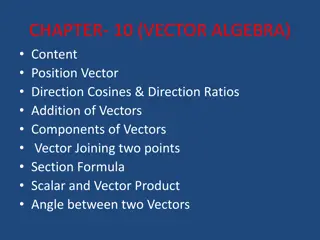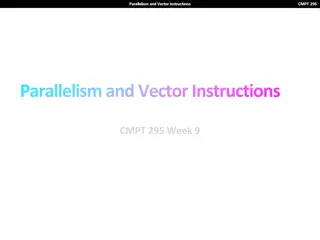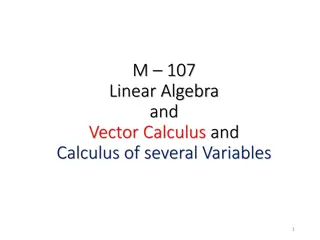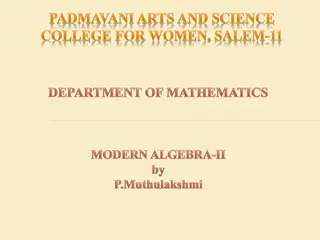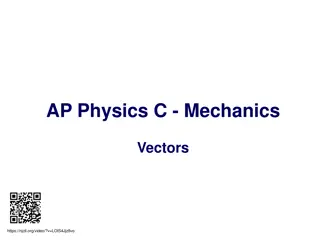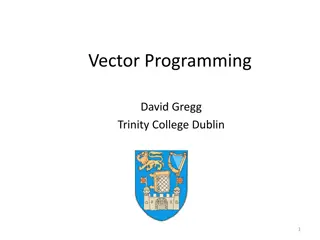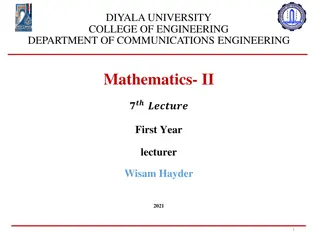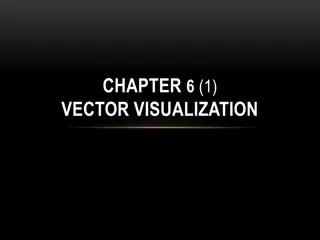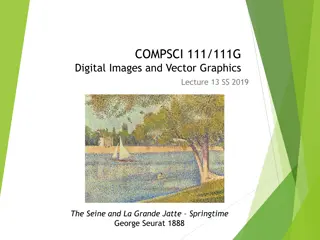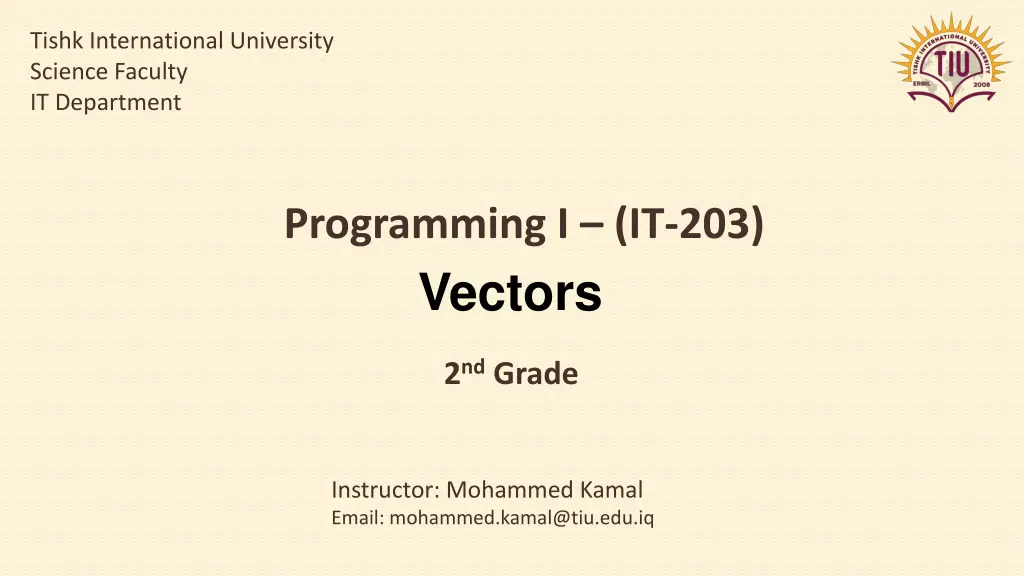
Understanding the Difference between Arrays and Vectors in C++
Explore the key dissimilarities between arrays and vectors in C++, showcasing how vectors offer dynamic resizing capabilities compared to the static nature of arrays. Gain insights into defining, using, and manipulating vectors while learning to erase specific elements efficiently.
Download Presentation

Please find below an Image/Link to download the presentation.
The content on the website is provided AS IS for your information and personal use only. It may not be sold, licensed, or shared on other websites without obtaining consent from the author. If you encounter any issues during the download, it is possible that the publisher has removed the file from their server.
You are allowed to download the files provided on this website for personal or commercial use, subject to the condition that they are used lawfully. All files are the property of their respective owners.
The content on the website is provided AS IS for your information and personal use only. It may not be sold, licensed, or shared on other websites without obtaining consent from the author.
E N D
Presentation Transcript
Tishk International University Science Faculty IT Department Programming I (IT-203) Vectors 2nd Grade Instructor: Mohammed Kamal Email: mohammed.kamal@tiu.edu.iq
Objectives Difference between array and vector Vector Defining a new vector Using Vector Using Vector Array Style Using Vector STL Operations on vector Deque Operations on Deque Array, Vector and Deque Erasing Specific Elements
Difference between array and vector In C++, arrays are used to store sequential data which are static in nature. Generally, arrays are non-dynamic, they are static, that is to say they are of fixed size. however, C++ also allows us to store data in dynamic arrays which are known as vectors, deques in C++.
Vector Vectors can resize itself automatically when an element is inserted or deleted depending on the need of the task to be executed. not same as an array where only a given number of values can be stored under a single variable name.
Vector Provides an alternative to the built-in array. A vector is self grown, resizable. Use It instead of the built-in array!
Defining a vector Syntax: : vector<of what> For example : vector<int> - vector of integers. vector<string> - vector of strings. vector<int * > - vector of pointers to integers. vector<Shape> - vector of Shape objects. Shape is a user defined class.
Defining a vector- cont.. #include <vector> Declaration: vector<type>identifiers(size); Example: vector<int> a(3); Example: vector<int> a(3,4); //0=>4 1=>4 2=>4 Example: vector<int> b; Vector can be indexed as an array, using [ ]
Defining a vector- cont.. In the above example, a blank vector is being created. Vector is a dynamic array and, doesn t need size declaration. #include <vector> usingnamespace std; intmain() { vector<int> my_vector; }
Using Vector #include <vector> Two ways to use the vector type: 1. Array style. 2. STL style
Insertion VectorName.push_back(valueToBeInserted); Inserts an element with value x at the end of the controlled sequence. svec.push_back(55); same as: vecID2.insert(vecID2.begin()+vecID2.size(), 55); Different from Svec[someIndex]=55; //works as array. You can t write an index bigger than what we have. Its has all array properties.
Using Vector Array Style We mimic the use of built-in array. voidmain() { constint N = 10; vector<int> ivec(N); for (int i=0; i < N; ++i) cin >> ivec[i]; int ia[N]; for ( int j = 0; j < N; ++j) ia[j] = ivec[j]; //{show elements of the vector} //{show elements of the array} System("pause"); }
Using Vector STL intmain() { int input; vector<int> ivec; /* rest of code */ while ( cin >> input ) ivec.push_back(input); }
Size intsize(); Returns the length of the controlled sequence (how many items it contains). int size = svec.size();
Using a vector STL style We define an empty vector vector<string> svec; we insert elements into the vector using the method push_back. string word; while ( cin >> word ) //the number of words is unlimited. { svec.push_back(word); }
Vectors Vector member functions: vector<int> v(10); deque<int> d(10); v.at(); // equal to v[ ] v.size(); // return the number of elements in v v.front(); // return the first element in v v.back(); // return the last element in v v.clear(); // delete all the element in v v.empty(); // return 1 if v is empty; else return 0; v.erase(); // erases a specific element v.begin(); //the beginning of the vector v.end(); //the end of the vector
Vectors v.resize( val ) // change size of v to val v.pop_back() // remove the last element in v v.push_back( val ) // appends val to the end of v v.capacity() hold before it will need to allocate more space // return the number of element that vector can http://www.cppreference.com/cppvector/all.html
How to do Vectors resize Example: vector<int> arr(10); arr.resize(12);
STL - Output for ( int i = 0; i < ivec.size(); ++i ) cout << ivec[i] << " "; cout << endl;
Putting it all together intmain() { int input; vector<int> ivec; // input while (cin >> input ) ivec.push_back(input); // output for ( int i=0; i<ivec.size(); i++) { cout << ivec.at(i) << " "; } cout << endl; return 0; }
Sequence Containers: vector The implementation of a vector is based on arrays Vectors allow direct access to any element via indexes Insertion at the end is normally efficient. The vector simply grows Insertion and deletion in the middle is expensive An entire portion of the vector needs to be moved 21
Sequence Containers: vector (cont.) When the vector capacity is reached then - A larger vector is allocated, - The elements of the previous vector are copied and - The old vector is deallocated To use vectors, we need to include the header <vector> Some functions of the class vector include - size, capacity, insert 22
Example of using the class vector #include <iostream> #include <vector> //vector class-template using namespace std; intmain() { vector<int> v; // add integers at the end of the vector v.push_back(2); v.push_back(3); v.push_back(4); cout << "\nThe size of v is: " << v.size() << "\nThe capacity of v is: " << v.capacity(); // display the content of v return 0; } 23
Vector Operations #include <vector> intmain() /* Output: 10 10 20 2 2 10 1 2 */ { vector<int> v; v.push_back(10); cout<<v[0]<<endl; v.push_back(20); cout<<v[0]<<" "<<v[1]<<endl; cout << v.size() << " " << v.capacity() << endl; v.pop_back(); print(v); cout << v.size() << " " << v.capacity() << endl; }
Vector Operations in function void abcd(vector<int> a) #include <iostream> { #include <vector> for (int j = 0; j < a.size(); j++) using namespace std; { cout << a[j] << endl; void abc(vector<int> &a) } } { for (int j = 0; j < a.size(); j++) { int main() a[j] = j + 1; { } vector<int> a(10); abc(a); } abcd(a); }
Vector of Vector == 2D Array Example1: vector<vector<int>> vec{ { 1, 2, 3 }, { 4, 5, 6 }, { 7, 8, 9, 4 } }; where vec is the vector of vectors with different number of columns in different rows Example2: v2 = {1, 2, 3} v1.push_back(v2); This function pushes vector v2 into vector of vectors v1. Therefore, v1 becomes { {1, 2, 3} }.
Vector Operations #include <iostream> for (int i = 0; i < vec.size(); i++) for (int i = 0; i < ROW; i++) #include <vector> { { using namespace std; for (int j = 0; j < vec[i].size(); j++) vector<int> v1; { for (int j = 0; j < COL; j++) int ROW = 4; cout << vec[i][j] << " "; { int COL = 5; cout << endl; v1.push_back(num); } num += 5; int main() } } { vector<vector<int> > vec; vec.push_back(v1); int num = 10; }
Deque Double Ended Queue Functionality similar to vectors, but with efficient insertion and deletion of elements also at the beginning of the sequence, and not only at its end Sequence Elements in sequence containers are ordered in a strict linear sequence. Individual elements are accessed by their position in this sequence.
Deque Operations #include <deque> /* Output: 1 2 0 * intmain() { deque<int> dq; dq.push_back(3); dq.push_front(1); dq.insert(de.begin() + 1, 2); dq[2] = 0; }
Sequence Containers STL provides three sequence containers - vector: based on arrays - deque (double-ended queue): based on arrays - list: based on linked lists 30
Sequence Containers: deque deque stands for double-ended queue deque combines the benefits of vector and list It provides indexed access using indexes (which is not possible using lists) It also provides efficient insertion and deletion in the front (which is not efficient using vectors) and the end 31
deque (cont.) Additional storage for a deque is allocated using blocks of memory - that are maintained as an array of pointers to those blocks Same basic functions as vector, in addition to that - deque supports push_front and pop_front for insertion and deletion at beginning of deque 32
Simple operations voidmain() { vector<string> ID; ID.insert(ID.begin(),"5"); ID.insert(ID.begin(), "5"); //cout << ID[0]; //cout << ID.front(); ID.insert(ID.begin()+2, "3"); cout << ID.at(0); cout << ID.at(1); system("pause"); }
Array and vector or deque voidmain() { int N = 10; vector<int> ivec(N); for (int i = 0; i < 10; ++i) ivec[i]=i; for (int i = 0; i < 10; ++i) cout << ivec[i] <<" "; int ia[10]; for (int j = 0; j < N; ++j) ia[j] = ivec[j]; system("pause"); }
Adding with to back int input; deque<int> ivec; cin >> input; while (input != -1) { ivec.push_back(input); cin >> input; } for (unsignedint i = 0; i < ivec.size(); i++) { cout << ivec.at(i) << " "; } cout << endl;
Adding to specific place cin >> input; while (input != -1) { ivec.insert(ivec.begin(),input); // ivec.insert(ivec.begin()+4,input); cin >> input; } for (unsignedint i = 0; i < ivec.size(); i++) { cout << ivec.at(i) << " "; } cout << endl;
Erasing Specific Element ivec.erase(ivec.end() - 2);// erases the second one ivec.erase(ivec.begin() + 2); //erases the 2 index for (unsignedint i = 0; i < ivec.size(); i++) { cout << ivec.at(i) << " "; } cout << endl;
Push_front, pop_front() ivec.push_front(0); ivec.push_back(0); for (unsignedint i = 0; i < ivec.size(); i++) { cout << ivec.at(i) << " "; } cout << endl; ivec.pop_back(); ivec.pop_front();




